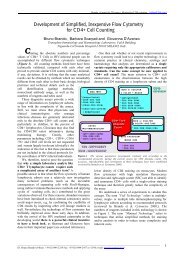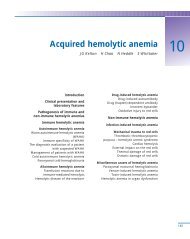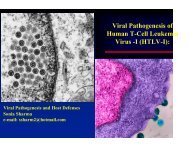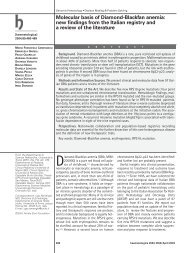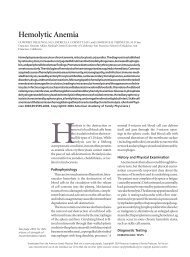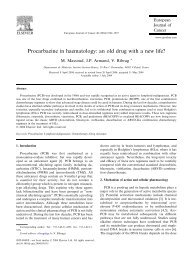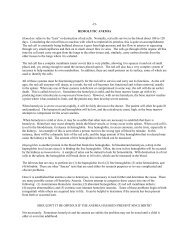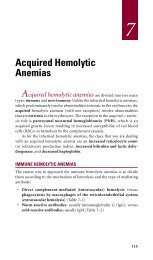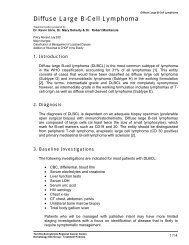The EORTC strategy in the treatment of Hodgkin's lymphoma
The EORTC strategy in the treatment of Hodgkin's lymphoma
The EORTC strategy in the treatment of Hodgkin's lymphoma
You also want an ePaper? Increase the reach of your titles
YUMPU automatically turns print PDFs into web optimized ePapers that Google loves.
Eghbali et al.<br />
aggressive and more extensive <strong>treatment</strong> <strong>in</strong> U cases<br />
accord<strong>in</strong>g to response and prognostic factors. All<br />
early stages (still accord<strong>in</strong>g to Ann Arbor criteria)<br />
<strong>in</strong> <strong>the</strong> H10F group will be treated by a front l<strong>in</strong>e<br />
chemo<strong>the</strong>rapy, those who are not <strong>in</strong> CR after two<br />
cycles <strong>of</strong> chemo<strong>the</strong>rapy as determ<strong>in</strong>ed by FDG–<br />
PET scan, will be treated accord<strong>in</strong>g to a different<br />
scheme than those who are <strong>in</strong> CR. Early complete<br />
remitters after two cycles <strong>of</strong> <strong>the</strong> front-l<strong>in</strong>e chemo<strong>the</strong>rapy<br />
will be treated with chemo<strong>the</strong>rapy only <strong>in</strong><br />
<strong>the</strong> experimental arm, whereas <strong>the</strong> standard arm<br />
still uses <strong>the</strong> comb<strong>in</strong>ed modality <strong>treatment</strong> regardless<br />
<strong>of</strong> <strong>the</strong> results <strong>of</strong> <strong>the</strong> FDG–PET scan after two<br />
cycles. Those <strong>in</strong> <strong>the</strong> F10U group will have <strong>the</strong> same<br />
approach with PET-scan but with more chemo<strong>the</strong>rapy.<br />
Hence <strong>in</strong> this trial <strong>the</strong> old prognostic<br />
system is comb<strong>in</strong>ed with a new dynamic factor,<br />
namely early response, and radio<strong>the</strong>rapy fields and<br />
dose are simultaneously discussed with a newly<br />
def<strong>in</strong>ition <strong>of</strong> <strong>in</strong>volved lymph node field <strong>in</strong>stead <strong>of</strong><br />
<strong>in</strong>volved area.<br />
At <strong>the</strong> o<strong>the</strong>r side <strong>of</strong> <strong>the</strong> spectrum, <strong>in</strong> <strong>the</strong><br />
advanced stages <strong>the</strong> general trend was to <strong>in</strong>tensify<br />
<strong>the</strong> <strong>treatment</strong> burden to overcome disease aggressiveness.<br />
<strong>The</strong> Lymphoma Group had compared<br />
MOPP to alternat<strong>in</strong>g MOPP and ABVD followed<br />
by optional radio<strong>the</strong>rapy (icebergs). This trial<br />
aimed to compare <strong>the</strong> new concept <strong>of</strong> alternat<strong>in</strong>g<br />
chemo<strong>the</strong>rapy to <strong>the</strong> standard (MOPP), but <strong>the</strong>re<br />
was any addressed question about radio<strong>the</strong>rapy<br />
(19). Later Cannellos and co-workers demonstrated<br />
that this alternat<strong>in</strong>g scheme gives <strong>the</strong> same results<br />
as hybrid MOPP/ABV and ABVD (25) lead<strong>in</strong>g to<br />
<strong>the</strong> f<strong>in</strong>al conclusion that ABVD could be considered<br />
as standard <strong>in</strong> advanced stages. <strong>The</strong> question<br />
<strong>of</strong> radio<strong>the</strong>rapy’s role <strong>in</strong> patients with CR after<br />
chemo<strong>the</strong>rapy was raised by <strong>the</strong> <strong>EORTC</strong> Lymphoma<br />
Group <strong>in</strong> its trial H3 and H4 (trial 20884).<br />
All patients with stage III or IV had front l<strong>in</strong>e<br />
MOPP/ABV. Those <strong>in</strong> CR after four courses had<br />
two more cycles and were randomised between<br />
24 Gy <strong>in</strong>volved field radio<strong>the</strong>rapy and observation.<br />
O<strong>the</strong>rs had four more cycles and were randomised<br />
after eight courses <strong>in</strong> <strong>the</strong> same way. All partial<br />
remitters were systematically irradiated on <strong>the</strong>ir<br />
<strong>in</strong>itial <strong>in</strong>volved fields (40 Gy) and progressions<br />
were put <strong>of</strong>f-study. After a median follow-up <strong>of</strong><br />
8 yr it appeared that complete remitters had no<br />
advantage from additional radio<strong>the</strong>rapy, complete<br />
remission after efficacious chemo<strong>the</strong>rapy proved to<br />
be enough <strong>treatment</strong> <strong>in</strong> advanced stages (26, 27). In<br />
this study however <strong>the</strong>re was no selection accord<strong>in</strong>g<br />
to prognostic factors and F cases were treated <strong>in</strong><br />
<strong>the</strong> same way as <strong>the</strong> U ones. <strong>The</strong> retrospective<br />
analysis accord<strong>in</strong>g to Hasenclever and Diehl (28)<br />
showed little help <strong>in</strong> divid<strong>in</strong>g <strong>the</strong> very good and <strong>the</strong><br />
worst cases. <strong>The</strong> latter is commonly known to have<br />
a very bad outcome. For a better result, if any, we<br />
began a trial compar<strong>in</strong>g eight cycles <strong>of</strong> standard<br />
ABVD to an association <strong>of</strong> four escalated BEA-<br />
COPP followed by four standard BEACOPP. This<br />
<strong>in</strong>ter-group trial <strong>in</strong> conjunction with <strong>the</strong> GELA and<br />
o<strong>the</strong>r <strong>in</strong>ternational collaborative groups (Nordic<br />
group, NCI Canada, British BNLI, Australian<br />
Lymphoma Group, Spanish Groups GELCAB<br />
and PETHEMA) is currently runn<strong>in</strong>g.<br />
However, all <strong>the</strong>se trials <strong>in</strong> early stages or<br />
advanced stages use old drugs and even old<br />
regimens. <strong>The</strong> AVBD was framed by Bonadonna<br />
more than 30 yr ago (29) and noth<strong>in</strong>g else s<strong>in</strong>ce has<br />
made this regimen obsolete. Every physician deal<strong>in</strong>g<br />
with HD knows its advantages and its toxicity<br />
and limits. New regimes are probably needed. Here<br />
also <strong>the</strong> limit is <strong>the</strong> high rate <strong>of</strong> cure, which makes<br />
any trial <strong>in</strong> standard cases non-ethical. In <strong>the</strong><br />
elderly however <strong>the</strong>re is a subset <strong>of</strong> patients with<br />
aggressive HD (stages III and IV) that is unable to<br />
have BEACOPP, at least with full dosage. For such<br />
patients, <strong>the</strong> Lymphoma Group <strong>in</strong> collaboration<br />
with <strong>the</strong> German Hodgk<strong>in</strong> Study Group began a<br />
trial us<strong>in</strong>g gemcitab<strong>in</strong>e <strong>in</strong>stead <strong>of</strong> bleomyc<strong>in</strong> and<br />
prednisone <strong>in</strong>stead <strong>of</strong> dacarbaz<strong>in</strong>e <strong>in</strong> <strong>the</strong> ABVD<br />
regimen. Whe<strong>the</strong>r this new regimen (named PVAG)<br />
with this new drug will be effective and non-toxic is<br />
too early to know s<strong>in</strong>ce this subset is very rare and<br />
<strong>the</strong> trial too recent.<br />
<strong>The</strong> HD is a cont<strong>in</strong>uous challenge for our m<strong>in</strong>ds. It<br />
was a long time ago <strong>the</strong> scheme <strong>of</strong> comb<strong>in</strong>ed<br />
modality <strong>treatment</strong>s <strong>in</strong> oncology for solid tumours<br />
and still rema<strong>in</strong>s a lead<strong>in</strong>g example <strong>of</strong> <strong>treatment</strong><br />
management, for a better <strong>treatment</strong> comb<strong>in</strong><strong>in</strong>g lesser<br />
toxicity and more efficacy. <strong>The</strong> <strong>EORTC</strong> Lymphoma<br />
Group is deeply <strong>in</strong>volved <strong>in</strong> this and currently has<br />
jo<strong>in</strong>ed o<strong>the</strong>r groups to face new challenges that<br />
appear recently along with new social, economic,<br />
medical, and politic conditions (30).<br />
References<br />
1. Noordijk EM, Carde P, Mandard AM, et al. Prelim<strong>in</strong>ary<br />
results <strong>of</strong> <strong>the</strong> <strong>EORTC</strong>-GPMC controlled trial H7 <strong>in</strong> earlystage<br />
Hodgk<strong>in</strong>’s disease. <strong>EORTC</strong> Lymphoma Cooperative<br />
Group, Groupe Pierre-et-Marie-Curie. Ann Oncol<br />
1994;5(Suppl. 2):S107–S112.<br />
2. Hagenbeek A, Carde P, Noordijk E, Thomas J, Tirelli<br />
U, Monconduit M, Eghbali H, Mandard AM, Henry-<br />
Amar M. Prognostic factor tailored <strong>treatment</strong> <strong>of</strong> early<br />
stage Hodgk<strong>in</strong>’s disease. Results from a prospective randomized<br />
phase III cl<strong>in</strong>ical trial <strong>in</strong> 762 patients (H7 study).<br />
39th Annual Meet<strong>in</strong>g <strong>of</strong> <strong>the</strong> American Society <strong>of</strong> Hematology<br />
(ASH). San Diego, December 5–9, 1997. Blood<br />
1997;90(Suppl. 1):585a (abstract 2603).<br />
3. Carde P, Noordijk E, Hagenbeek A, et al. for <strong>the</strong><br />
<strong>EORTC</strong> Lymphoma Cooperative Group and <strong>the</strong> Groupe<br />
Pierre-et-Marie-Curie. Superiority <strong>of</strong> EBVP chemo<strong>the</strong>rapy<br />
<strong>in</strong> comb<strong>in</strong>ation with <strong>in</strong>volved field irradiation over subtotal<br />
nodal irradiation <strong>in</strong> favorable cl<strong>in</strong>ical stage I-II Hodgk<strong>in</strong>’s<br />
138



